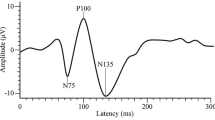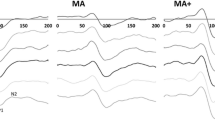Abstract
A lack of habituation in visual-evoked potentials (VEPs) is the main abnormality observed in migraineurs. However, no study of steady-state VEPs has yet evaluated pattern-reversal stimuli with respect to habituation behavior or spatial frequency. The aim of this study was to clarify habituation behavior in migraineurs between attacks and to establish characteristics of VEPs in these patients. Steady-state VEPs were sequentially recorded as checkerboard patterns in four consecutive blocks from 12 patients with migraine without aura (MO), 12 patients with migraine with aura (MA), and 12 healthy controls (HC) at four spatial frequencies of 0.5, 1.0, 2.0, and 4.0 cycles per degree (cpd) with a stimulus rate of 7.5 Hz (15 reversal/s). VEP amplitudes were consistently higher in migraineurs. However, habituation was not demonstrated in HCs, and migraineurs did not reveal a clear lack of habituation. MAs exhibited high-amplitude VEPs, depending on spatial frequency. In the MA patients, amplitude differences reached statistical significance at 2.0 cpd. The sequential amplitude changes at 0.5 cpd were significantly different in MAs compared with HCs. Migraine patients exhibited high-amplitude VEPs, which were dependent on spatial frequency, and may be related to altered excitability in pre-cortical and cortical visual processing.



Similar content being viewed by others
References
Welch KM (2003) Contemporary concepts of migraine pathogenesis. Neurology 61:S2–S8
Berger M, Speckmann E-J, Pape HC, Gorji A (2008) Spreading depression enhances human neocortical excitability in vitro. Cephalalgia 28:558–562
Schoenen J, Wang W, Albert A, Delwaide PJ (1995) Potentiation instead of habituation characterizes visual evoked potentials in migraine patients between attack. Eur J Neurol 2:115–122
Áfra J, Cecchini AP, De Pasqua V, Albert A, Schoenen J (1998) Visual evoked potentials during long periods of pattern-reversal stimulation in migraine. Brain 121:233–241
Sándor PS, Áfra J, Cecchini AP, Albert A, Schoenen J (1999) Familial influences on cortical evoked potentials in migraine. Neuroreport 26:1235–1238
Wang W, Wang GP, Ding XL, Wang YH (1999) Personality and response to repeated visual stimulation in migraine and tension-type headaches. Cephalalgia 19:718–724
Bohotin V, Fumal A, Vandenheede M, Gérard P, Bohotin C, Maertens de Noordhout A, Schoenen J (2002) Effects of repetitive transcranial magnetic stimulation on visual evoked potentials in migraine. Brain 125:912–922
Fumal A, Coppola G, Bohotin V, Gérardy PY, Seidel L, Donneau AF, Vandenheede M, Maertens de Noordhout A, Schoenen J (2006) Induction of long-lasting changes of visual cortex excitability by five daily sessions repetitive transcranial magnetic stimulation (rTMS) in healthy volunteers and migraine patients. Cephalalgia 26:143–149
Coppola G, Ambrosini A, Di Clemete L, Magis D, Fumal A, Gérard P, Pierelli F, Schoenen J (2007) Interictal abnormalities of gamma band activity in visual evoked responses in migraine: an indication of thalamocortical dysfunction? Cephalalgia 27:1323–1330
Magis D, Allena M, Coppola G, Di Clemente L, Gérard P, Schoenen J (2007) Search for correlations between genotypes and electrophysiological patterns in migraine: the MTHFR C677T polymorphism and visual evoked potentials. Cephalalgia 27:1142–1149
Schoenen J, Ambrosini A, Sándor PS, de Noordhout AM (2003) Evoked potentials and transcranial magnetic stimulation in migraine: published data and viewpoint on their pathophysiologic significance. Clin Neurophysiol 114:955–972
Coppola G, Pierelli F, Schoenen J (2007) Is the cerebral cortex hyperexcitable or hyperresponsive in migraine? Cephalalgia 27:1429–1439
Shibata K, Osawa M, Iwata I (1997) Pattern reversal visual evoked potentials in classic and common migraine. J Neurol Sci 145:177–181
Oelkers R, Grosser K, Lang E, Geisslinger G, Kobal G, Brune K, Lötsch J (1999) Visual evoked potentials in migraine patients: alterations depend on pattern spatial frequency. Brain 122:1147–1155
Sand T, Zhiniy N, White LR, Stovner LJ (2008) Visual evoked potential latency, amplitude and habituation in migraine: a longitudinal study. Clin Neurophysiol 119:1020–1027
Simon RH, Zimmerman AW, Tasman A, Hale MS (1982) Spectral analysis of photic stimulation in migraine. Electroencephalogr Clin Neurophysiol 53:270–276
Nyrke T, Lang AH (1982) Spectral analysis of visual potentials evoked by sine wave modulated light in migraine. Electroencephalogr Clin Neurophysiol 53:436–442
Nyrke T, Kangasniemi P, Lang AH, Petersen E (1984) Steady-state visual evoked potentials during migraine prophylaxis by propranolol and femoxetine. Acta Neurol Scand 69:9–14
Nyrke T, Kangasniemi P, Lang AH (1989) Difference of steady-state visual evoked potentials in classic and common migraine. Electroencephalogr Clin Neurophysiol 73:285–294
Nyrke T, Kangasniemi P, Lang AH (1990) Transient asymmetric of steady-state visual evoked potentials in classic migraine. Headache 30:133–137
Genco D, de Tommaso N, Prudenzano AM, Savarese M, Puca FM (1994) EEG features in juvenile migraine: topographic analysis of spontaneous and visual evoked brain electrical activity: a comparison with adult migraine. Cephalalgia 14:41–46
Puca FM, de Tommaso M, Tota P, Sciruicchio V (1996) Photic driving in migraine: correlations with clinical features. Cephalalgia 16:246–250
de Tommaso M, Sciruicchio V, Guido M, Sasanelli G, Specchio LM, Puca FM (1998) EEG spectral analysis in migraine without aura attacks. Cephalalgia 18:324–328
de Tommaso M, Sciruicchio V, Guido M, Sasanelli G, Puca F (1999) Steady-state visual-evoked potentials in headache: diagnostic value in migraine and tension-type headache patients. Cephalalgia 19:23–26
de Tommaso M, Marinazzo D, Guido M, Libro G, Stramaglia S, Nitti L, Lattanzi G, Angelini L, Pellicoro M (2005) Visually evoked phase synchronization changes of alpha rhythm in migraine: correlations with clinical features. Int J Psychophysiol 57:203–210
de Tommaso M, Marinazzo D, Nitti L, Pellicoro M, Guido M, Serpino C, Stramaglia S (2007) Effects of levetiracetam vs. topiramate and placebo on visually evoked phase synchronization changes of alpha rhythm in migraine. Clin Neurophysiol 118:2297–2304
Angelini L, de Tommaso M, Guido M, Hu K, Ivanov PCh, Marinazzo D, Nardulli G, Nitti L, Pellicoro M, Pierro C, Stramaglia S (2004) Steady-state visual evoked potentials and phase synchronization in migraine patients. Phys Rev Lett 93:038103 1–4
de Tommaso M, Stramaglia S, Schoffelen JM, Guido M, Libro G, Losito L, Sciruicchio V, Sardaro M, Pellicoro M, Puca FM (2003) Steady-state visual evoked potentials in the low frequency range in migraine: a study of habituation and variability phenomena. Int J Psychophysiol 49:165–174
Headache Classification Subcommittee of the International Headache Society (2004) The international classification of headache disorders, 2nd edn. Cephalalgia 24(suppl 1):1–160
Shibata K, Yamane K, Otuka K, Iwata M (2008) Abnormal visual processing in migraine with aura: a study of steady-state visual evoked potentials. J Neurol Sci 271:119–126
Khalil NM, Legg NJ, Anderson DJ (2000) Long term decline of P100 amplitude in migraine aura. J Neurol Neurosurg Psychiatry 69:507–511
Sand T, Vingen JV (2000) Visual, long-latency auditory and brainstem auditory evoked potentials in migraine: relation to pattern size, stimulus intensity, sound and light discomfort thresholds and pre-attack state. Cephalalgia 20:804–820
Chen WT, Wang SJ, Fuh JL, Lin CP, Ko YC, Lin YY (2009) Peri-ictal normalization of visual cortex excitability in migraine: an MEG study. Cephalalgia 29:1202–1211
Thompson RF, Spencer WA (1966) Habituation: a model phenomenon for the study of neuronal substrates of behavior. Psychol Rev 73:16–43
Diener HC, Sholtz E, Dichgans J, Gerber WD, Jäck A, Bille A, Niederberger U (1989) Central effects of drugs used in migraine prophylaxis evaluated by visual evoked potentials. Ann Neurol 25:125–130
Regan D (1989) Human brain electrophysiology; evoked potentials and evoked magnetic field in science and medicine. Elsevier, Amsterdam
Shibata K, Yamane K, Iwata M, Ohkawa S (2005) Evaluating the effects of spatial frequency on migraines by using pattern-reversal visual evoked potentials. Clin Neurophysiol 116:2220–2227
Kennard C, Gawel M, Rudolph NM, Rose FC (1978) Visual evoked potentials in migraine subjects. Headache 6:73–80
Polich J, Ehlers CL, Dalessio DJ (1986) Pattern-shift visual evoked responses and EEG in migraine. Headache 26:451–456
Mariani E, Moschini V, Pastorino G, Rizzi F, Severgnini A, Tiengo M (1988) Pattern-reversal visual evoked potentials and EEG correlations in common migraine patients. Headache 28:269–271
Drake ME, Pakalnis A, Hietter SA, Padamandan H (1990) Visual and auditory evoked potentials in migraine. Electromyogr Clin Neurophysiol 30:77–81
Tagliati M, Sabbadini M, Bernardi G, Silvestrini M (1995) Multichannel visual evoked potentials in migraine. Electroencephalogr Clin Neurophysiol 96:1–5
Sener HO, Haktanir I, Demirci S (1997) Pattern-reversal visual evoked potentials in migraineurs with or without aura. Headache 37:449–451
Aurora SK, Barrodale P, Chronicle EP, Mulleners WM (2005) Cortical inhibition is reduced in chronic and episodic migraine and demonstrates a spectrum of illness. Headache 45:546–552
Aurora SK, Wilkinson F (2007) The brain is hyperexcitable in migraine. Cephalalgia 27:1442–1453
Livingstone M, Hubel D (1988) Segregation of form, color, movement, and depth: anatomy, physiology, and perception. Science 240:740–749
Bassi CJ, Lehmkuhle S (1990) Clinical implications of parallel visual pathways. J Am Optom Assoc 61:98–110
Khalil NM (1991) Investigations of visual function in migraine using visual evoked potentials and visual psychophysical tests. PhD thesis, University of London
Coleston DM, Chronicle E, Ruddock KH, Kennard C (1994) Precortical dysfunction of spatial and temporal visual processing in migraine. J Neurol Neurosurg Psychiatry 57:1208–1211
Benedek K, Tajti J, Janáky M, Vécsei L, Benedek G (2002) Spatial contrast sensitivity of migraine patients without aura. Cephalalgia 22:142–145
Huang J, Cooper TG, Satana B, Kaufman DI, Cao Y (2003) Visual distortion provoked by a stimulus in migraine associated with hyperneuronal activity. Headache 43:664–671
Kowacs PA, Piovesan EJ, Werneck LC, Fameli H, Zani AC, da Silva HP (2005) Critical flicker frequency in migraine. A controlled study in patients without prophylactic therapy. Cephalalgia 25:339–343
McKendrick AM, Badcock DR (2003) Contrast-processing dysfunction in both magnocellular and parvocellular pathways in migraineurs both with or without aura. Invest Ophthalmol Vis Sci 44:442–448
McKendrick AM, Vingrys AJ, Badcock DR, Heywood JT (2001) Visual dysfunction between migraine events. Invest Ophthalmol Vis Sci 42:626–633
McKendrick AM, Sampson GP (2009) Low spatial frequency contrast sensitivity deficits in migraine are not visual pathway selective. Cephalalgia 29:539–549
Harle DE, Evans BJW (2005) Frequency doubling technology perimetry and standard automated perimetry in migraine. Ophthal Physiol Opt 25:233–239
Omland PM, Nilsen KB, Sand T (2011) Habituation measured by pattern reversal visual evoked potentials depends more on check size than reversal rate. Clin Neurophysiol (in press)
McKendrick AM, Badcock DR (2004) Motion processing deficits in migraine. Cephalalgia 24:363–372
Porciatti V, Sartucci F (1999) Normative data for onset VEPs to red-green and blue-yellow chromatic contrast. Clin Neurophysiol 110:772–781
Shibata K, Yamane K, Iwata M (2006) Change of excitability in brainstem and cortical visual processing in migraine exhibiting allodynia. Headache 46:1535–1544
Kelly DH (1976) Pattern detection and the two-dimensional fourier transform: flickering checkerboards and chromatic mechanisms. Vis Res 16:277–287
Schechter I, Butler P, Zemon VM, Revheim N, Saperstein AM, Jalbrzikowski M, Pasternak R, Silipo G, Javitt DC (2005) Impairments in generation of early-stage transient visual evoked potentials to magno- and parvocellular-selective stimuli in schizophrenia. Clin Neurophysiol 116:2204–2215
Tobimatsu S, Celesia GG (2006) Studies of human visual pathophysiology with visual evoked potentials. Clin Neurophysiol 117:1414–1433
Conflict of interest
None.
Author information
Authors and Affiliations
Corresponding author
Rights and permissions
About this article
Cite this article
Shibata, K., Yamane, K., Nishimura, Y. et al. Spatial frequency differentially affects habituation in migraineurs: a steady-state visual-evoked potential study. Doc Ophthalmol 123, 65–73 (2011). https://doi.org/10.1007/s10633-011-9281-2
Received:
Accepted:
Published:
Issue Date:
DOI: https://doi.org/10.1007/s10633-011-9281-2




